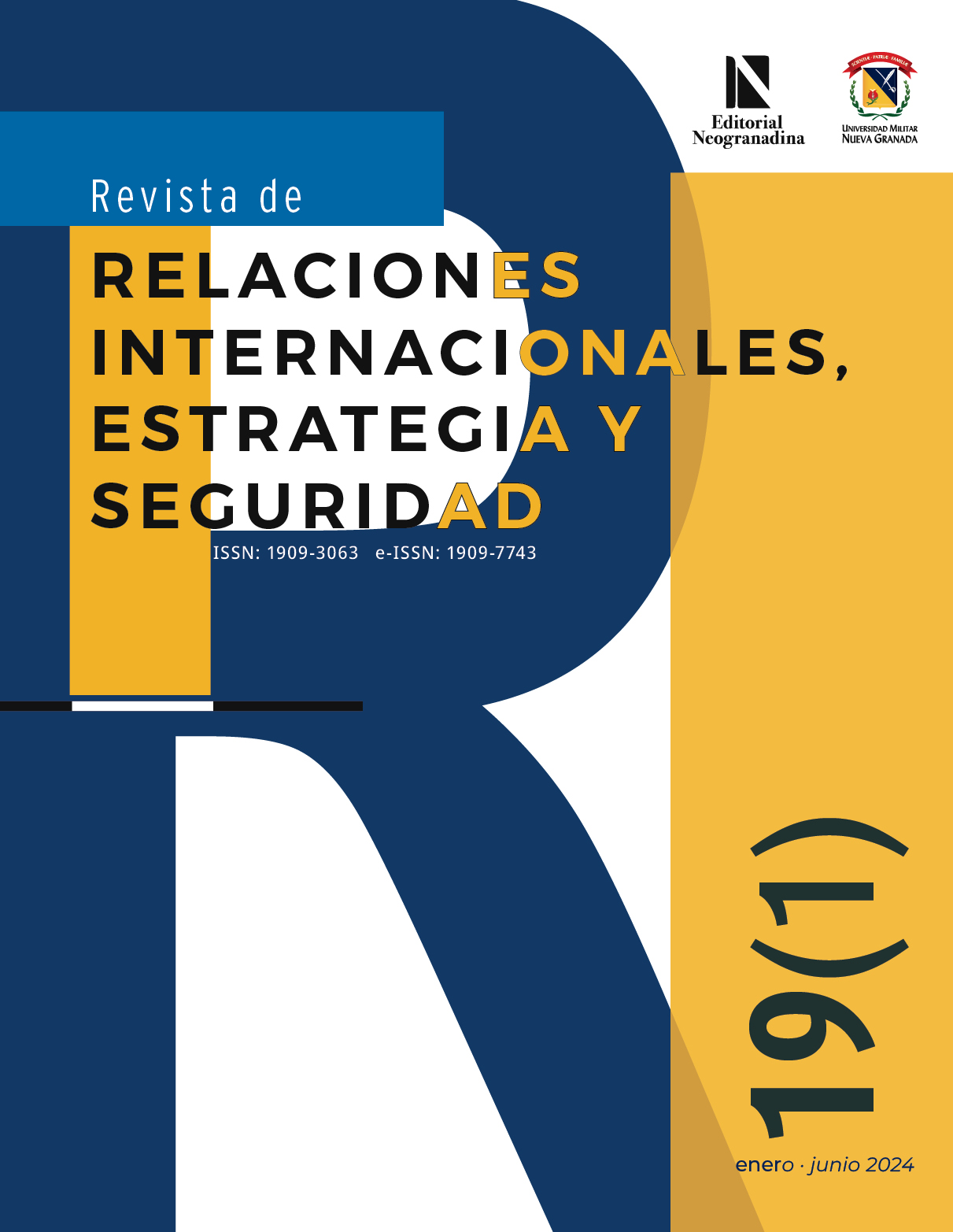A Cybersecurity strategy for the Colombian port infrastructure
Abstract
In light of the global maritime context and Colombia’s significant reliance on maritime shipping, which constitutes approximately 98.8 % of its foreign trade, with 98.2 % of imported goods primarily transported in containers (DIMAR, 2020), it is imperative to embrace technologies such as single windows for online procedures and payments of port services, electronic document man- agement, and communications of strategic importance to the nation. Additionally, the implemen- tation of automatic cargo handling systems and operational automation, inherently carrying cyber risks, is crucial and approached from the perspective of port infrastructure as a critical nations asset. Within this framework, this article aims to propose a cybersecurity strategy for Colombian port in- frastructure, comparing it with other cybersecurity strategies in the global maritime sector. A qual- itative methodology was employed for information selection, utilizing academic repositories and web search engines to identify cybersecurity strategies developed by countries such as the United States. The article is structured into four subsections covering the international scope, global port infrastructure, associated cyber risks, and finally, the Colombian Port Cybersecurity Strategy. The conclusion underscores the challenges posed by strategy implementation and the involvement of diverse organizations engaged in port and maritime operations as critical hurdles that the nation must address for the prevention of cyberterrorism in this vital infrastructure.
Downloads
References
Aguilar, J. M. (2021). Retos y oportunidades en materia de ciberseguridad de América Latina frente al contexto global de ciberamenazas a la seguridad nacional y po- lítica exterior. Estudios Internacionales, 53(198). http://dx.doi.org/10.5354/0719-3769.2021.57067
Aguilar, J. M. (2020). Brecha de ciberseguridad en Améri- ca Latina. Revista de Estudios en Seguridad Internacional (resi), 6(2). http://dx.doi.org/10.18847/1.12.2
Aguilar, J. M. (2019). Hechos ciberfísicos: una propuesta de análisis para ciberamenazas en las Estrategias Nacionales de Ciberseguridad. Urvio. Revista Latinoamericana de Estudios de Seguridad, 4299(25), 24-40. https://doi.org/10.17141/urvio.25.2019.4007
Banco Interamericano de Desarrollo (bid). (2020). Manual de Puertos Inteligentes.
Banco Interamericano de Desarrollo (bid). (2020). Ci- berseguridad, riesgos, avances y el camino a seguir en América Latina y el Caribe. bid-oea, 1, 116-119. https://publications.iadb.org/es/reporte-ciberseguridad-2020-riesgos-avances-y-el-camino-a-seguir-en-america-latina-y-el-caribe
BID. (2016). Ciberseguridad ¿Estamos preparados en América Latina y el Caribe?: Informe Ciberseguridad 2016. Observatorio de la Ciberseguridad en América Latina y el Caribe, 193. https://www.observatoriociberseguridad.com
Bimco. (2021). The Guidelines on Cyber Security Onboard Ships. International Chambber of Shippinger of Shipping, 4, 1-53.
Cepal. (2020). La ciberseguridad en tiempos del covid-19 y el tránsito hacia una ciberinmunidad. FAL, Boletín 382. Cepal. (Internet). https://repositorio.cepal.org/bitstream/handle/11362/46275/S2000679_es.pdf?se- quence=1&isAllowed=y
Departamento Nacional de Planeación (dnp). (2011). Lineamientos de política para ciberseguridad y ciberdefensa. Conpes 3701-2011. Consejo Nacional de Política Económica y Social. (Internet), 43.
Departamento de Seguridad Nacional-Gobierno de España. (2020). Informe Anual de Seguridad Nacional 2019. Defensa de Seguridad Nacional, 280. https://www.cisco.com/web/offer/gist_ty2_asset/Informe_anual_de_ seguridad_de_Cisco_de_2013.pdf
Departamento de Seguridad Nacional. (2019). Estrategia Nacional de Ciberseguridad, 1-68. https://www.dsn.gob.es/es/documento/estrategia-nacional-ciberseguridad-2019
Department of Home Affairs. (2020). Australia’s 2020 Cyber Security Strategy: Industry Advisory Panel Report. (Internet). https://www.homeaffairs.gov.au/cyber-security-subsite/files/2020-cyber-security-strategy-iap-report.pdf
Díaz, R. M. (2021). Estado de la ciberseguridad en la lo- gística de América Latina y el Caribe 228. Desarrollo productivo. Cepal, 1-68.
Drougkas, A., Sarri, A. y Kyranoudi, P. (2020). Cyber Risk Management For Ports.
Drougkas, A., Sarri, A., Kyranoudi, P. y Zisi, A. (2019). Port cybersecurity: good practices for cybersecurity in the maritime sector. In Enisa.
Departamento de Estado (ee. uu.). (2015). dod Cyber Strategy, 91.
Godoy, L. (2022). Observatorio de Economía Compleja. https://oec.world/es/profile/country/col
Gobierno de México. (2017). Estrategia Nacional de Ciberseguridad. https://www.gob.mx/cms/uploads/attachment/file/271884/Estrategia_Nacional_Ciberseguridad.pdf
Ministerio de Ciencia, Innovación, Tecnología y Telecomunicaciones (miccitt). (2017). Estrategia Nacional de Ciberseguridad de Costa Rica. (Internet). http://www.conicit.go.cr/ver/sic/biblioteca_virtual/publicaciones/publica_cyt/otros_doc_cyt/Estrategia-Nacional-Ciberseguridad-CR-19-10-17.pdf
Moteff, J., Copeland, C., Fischer, J., Ave, I. y Washington, S. E. (2003). Report for Congress Received through the crs Web Critical Infrastructures: What Makes an Infrastructure Critical? Time, 21. https://irp.fas.org/crs/RL31556.pdf
NorwegianMinisteries. (2019). NationalCyberSecurityStrategy for Norway. (Internet). https://www.regjeringen.no/contentassets/c57a0733652f47688294934ffd93fc53/national-cyber-security-strategy-for-norway.pdf
Organización de Estados Americanos (oea). (2021). Marítima: la seguridad cibernética en el hemisferio occi- dental. Introducción y directrices. Organización de Estados Americanos.
Organización Marítima Internacional (omi). (2017). Directrices sobre la gestión de los riesgos cibernéticos marítimos. Documento omi, msc-fal. 1(0), 7. http://www.imo.org/es/OurWork/Security/Guide_to_Maritime_ Security/Documents/MSC-FAL.1-Circ.3 - Directrices Sobre La Gestión De Los Riesgos Cibernéticos Marítimos (Secretaría) (1).pdf
Organización Marítima Internacional (omi). (2021, junio). Resolución msc.428(98). https://wwwcdn.imo.org/localresources/es/OurWork/Security/Documents/Pages from MSC 98-23-Add.1 - Anexo 10.pdf
Public Safety Canada. (2018). National Cyber Security Strategy: Canada’s Vision for Security and Prosperity in the Digital Age. In Public Safety Canada. https://www.publicsafety.gc.ca/cnt/rsrcs/pblctns/ntnl-cbrscrt-strtg/index-en.aspx?wbdisable=true
Rodrigo, G. N. (2020). Ciberataques a la logística y la in- fraestructura crítica en América Latina y el Caribe. 60.
Secretaría de la Marina. (2021). Estrategia Institucional en el Ciberespacio 2021-2024. Armada de México.
Siegel, C. A. y Sweeney, M. (2023, noviembre). Cyber Stra- tegy. 1a. edición. Auerbach Publications. https://doi.org/10.1201/9780429323003
Trump, D. J. (2020). National Strategy for Maritime Secu- rity. (Internet). https://trumpwhitehouse.archives.gov/wp-content/uploads/2021/01/12.2.2020-National-Maritime-Cybersecurity-Plan.pdf
US Coast Guard. (2020). Vessel Cyber Risk Management Work Instruction. 027(1), 1-7. https://safety4sea.com/wp-content/uploads/2020/11/USCG-CVC-WI-027- “Vessel-Cyber-Risk-Management”-2020_10.pdf
US Department of Homeland Security. (2018). dhs cybersecurity strategy. 35. https://www.dhs.gov/publication/dhs-cybersecurity-strategy
Yee, V. y Glanz, J. (2021). Así fue como el Ever Given se atascó en el Canal de Suez. New York Times. https://www.nytimes.com/es/2021/07/19/espanol/canal-suez-evergiven.html
Wilshusen, G. C. (2015). Cybersecurity: Actions Needed to Address Challenges Facing Federal Systems. (Internet). https://oversight.house.gov/wp-content/uploads/2015/04/Wilshusen-Testimony.pdf
Zambrano, A. y Hernández, L. (2020). Centroamérica Cibersegura.

Copyright (c) 2024 Revista de Relaciones Internacionales, Estrategia y Seguridad

This work is licensed under a Creative Commons Attribution-NonCommercial-NoDerivatives 4.0 International License.











